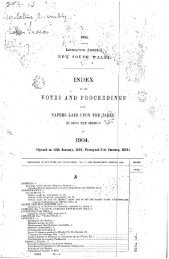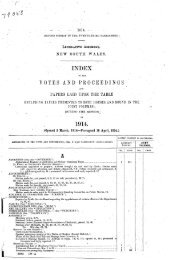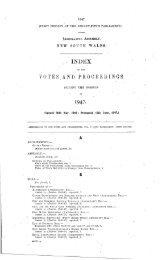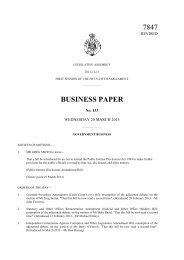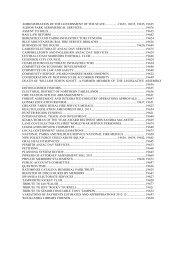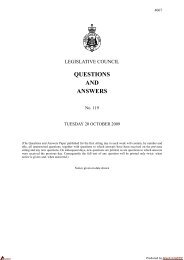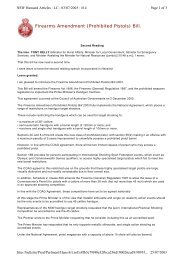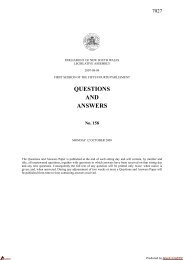Endeavour Energy Annual Performance Report - Parliament of New ...
Endeavour Energy Annual Performance Report - Parliament of New ...
Endeavour Energy Annual Performance Report - Parliament of New ...
You also want an ePaper? Increase the reach of your titles
YUMPU automatically turns print PDFs into web optimized ePapers that Google loves.
2 Statement <strong>of</strong> Significant<br />
Accounting Policies<br />
continued<br />
All other provisions have been<br />
calculated at nominal amounts<br />
based on expected settlement rates.<br />
Defined contribution plans<br />
A defined contribution plan is a postemployment<br />
benefit under which an<br />
entity pays fixed contributions into<br />
a separate entity and will have no<br />
legal or constructive obligation to<br />
pay further amounts. Obligations for<br />
contributions to defined contribution<br />
plans are recognised as an employee<br />
benefit expense in pr<strong>of</strong>it or loss in<br />
the periods during which services<br />
are rendered by employees.<br />
Defined benefit plans<br />
A defined benefit plan is a postemployment<br />
benefit plan other than<br />
a defined contribution plan. The<br />
net obligation in respect <strong>of</strong> defined<br />
benefit plans is calculated separately<br />
for each plan by estimating the<br />
future benefit that employees have<br />
earned in return for their service in<br />
the current and prior periods – that<br />
benefit is discounted to determine<br />
its present value. Any unrecognised<br />
past service costs and the fair value<br />
<strong>of</strong> any plan assets are deducted.<br />
The calculation is performed<br />
annually by a qualified actuary using<br />
the projected unit credit method.<br />
All actuarial gains and losses<br />
arising from defined benefit<br />
plans are recognised in other<br />
comprehensive income.<br />
(ii) Restructuring Provision<br />
A restructuring provision in relation<br />
to the sale <strong>of</strong> the Retail business has<br />
been recognised in accordance with<br />
AASB 137 Provisions, Contingent<br />
Liabilities and Contingent Assets. In<br />
arriving at the total amount provided<br />
for, the Corporation has followed<br />
a detailed plan <strong>of</strong> restructuring<br />
resulting from the sale <strong>of</strong> the Retail<br />
business, including details <strong>of</strong> the<br />
location and number <strong>of</strong> employees<br />
affected, and associated timelines.<br />
Individuals affected have a valid<br />
expectation that the restructuring<br />
is being carried out.<br />
(p) Derivative financial<br />
instruments<br />
<strong>Endeavour</strong> <strong>Energy</strong> uses derivative<br />
financial instruments to hedge its<br />
exposure to commodity (electricity,<br />
aluminium and copper) price<br />
risk, interest rate risk and foreign<br />
exchange risk. Such derivative<br />
financial instruments are initially<br />
recognised at fair value on the date<br />
the derivative is entered into and<br />
any gains or losses on subsequent<br />
remeasurement are recognised in<br />
pr<strong>of</strong>it or loss unless the derivative<br />
is designated and effective as a<br />
hedging instrument, in which case<br />
the timing <strong>of</strong> the recognition in pr<strong>of</strong>it<br />
or loss depends on the ongoing<br />
effectiveness <strong>of</strong> the hedge or<br />
maturity <strong>of</strong> the hedging instrument.<br />
The fair value <strong>of</strong> any financial<br />
derivative contract is calculated<br />
by reference to current forward<br />
rates for contracts with similar<br />
maturity pr<strong>of</strong>iles.<br />
Derivatives are carried as assets<br />
when their fair value is positive<br />
and liabilities when their fair value<br />
is negative.<br />
Derivative assets and liabilities are<br />
classified as current in the Statement<br />
<strong>of</strong> Financial Position when the<br />
remaining maturity is less than<br />
12 months, or non current when the<br />
remaining maturity is more than<br />
12 months.<br />
Hedge accounting<br />
For the purposes <strong>of</strong> hedge<br />
accounting, hedges are classified as<br />
either fair value hedges when they<br />
hedge the exposure to changes in<br />
the fair value <strong>of</strong> a recognised asset or<br />
liability, or cash flow hedges where<br />
they hedge exposure to variability in<br />
cash flows that is either attributable<br />
to a particular risk associated with<br />
a recognised asset or liability or a<br />
highly probable forecast transaction.<br />
Cash flow hedges<br />
In relation to cash flow hedges to<br />
hedge firm commitments which<br />
meet the conditions for hedge<br />
accounting, the portion <strong>of</strong> the gain<br />
or loss on the hedging instrument<br />
that is determined to be an effective<br />
hedge is recognised in other<br />
comprehensive income and the<br />
ineffective portion is recognised<br />
in pr<strong>of</strong>it or loss. When the hedged<br />
firm commitment results in the<br />
recognition <strong>of</strong> an asset or a liability,<br />
then, at the time the asset or liability<br />
is recognised, the associated gains<br />
or losses that had previously been<br />
recognised in other comprehensive<br />
income are included in the initial<br />
measurement <strong>of</strong> the acquisition cost<br />
or other carrying amount <strong>of</strong> the asset<br />
or liability.<br />
For all other cash flow hedges, the<br />
gains or losses that are recognised<br />
in other comprehensive income are<br />
transferred to pr<strong>of</strong>it or loss in the<br />
same period in which the hedged<br />
firm commitment affects the net<br />
pr<strong>of</strong>it and loss. Fair value has been<br />
determined at year end through<br />
the use <strong>of</strong> valuation techniques<br />
using cash flow estimates based<br />
on observable commodity forward<br />
price curves and available financial<br />
market rates.<br />
Hedge accounting is discontinued<br />
when the hedging instrument<br />
expires or is sold, terminated or<br />
exercised, or no longer qualifies<br />
for hedge accounting. At that<br />
point in time, any cumulative gain<br />
or loss on the hedging instrument<br />
recognised in other comprehensive<br />
income remains until the forecasted<br />
transaction occurs. If a hedged<br />
transaction is no longer expected to<br />
occur, the net cumulative gain or loss<br />
recognised in other comprehensive<br />
income is transferred to pr<strong>of</strong>it or loss<br />
for the period.<br />
Derivatives that do not qualify<br />
for hedge accounting<br />
Derivatives that do not qualify for<br />
hedge accounting are designated<br />
as held for trading. Gains or<br />
losses on derivatives held for<br />
trading are recognised in pr<strong>of</strong>it<br />
or loss and the related assets or<br />
liabilities are classified as derivative<br />
financial assets in the Statement<br />
<strong>of</strong> Financial Position.<br />
<strong>Endeavour</strong> <strong>Energy</strong> <strong>Annual</strong> <strong>Performance</strong> <strong>Report</strong> 2010–11<br />
59



